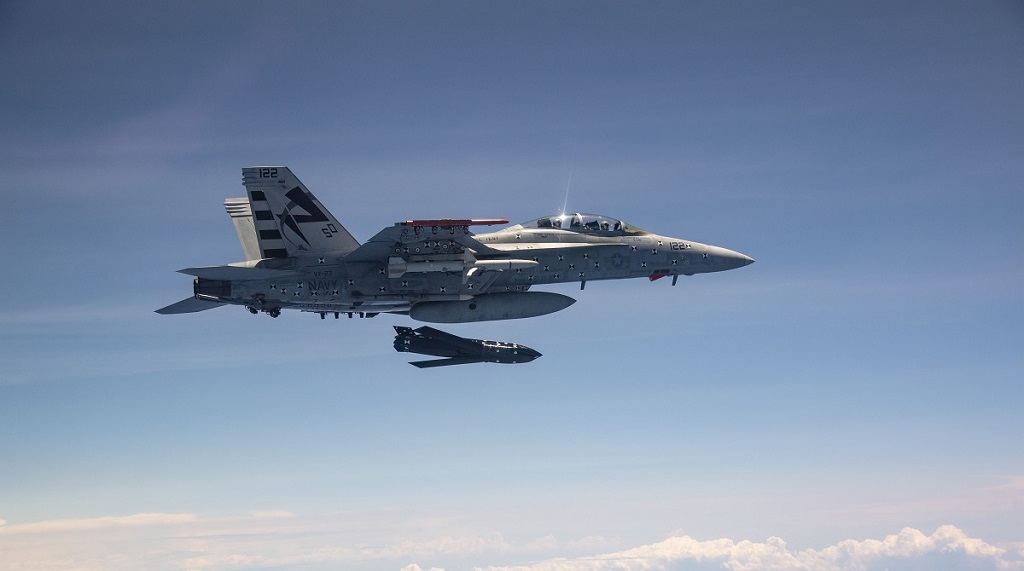U.S. Navy Tests Four LRASM Missiles Simultaneously In Flight


The latest Integrated Test Event is considered a “graduation exercise” of the latest configuration of the weapon.
The U.S. Navy and Lockheed Martin successfully completed the 12th Integrated Test Event of the Long-Range Anti-Ship Missile (LRASM) with four missiles simultaneously in flight. The service was able to demonstrate the weapon’s inherent high-end lethality from mission planning through kill chain integration and its effects on the target, meeting all test objectives.
The AGM-158C LRASM, based on the AGM-158B Joint Air-to-Surface Standoff Missile – Extended Range (JASSM-ER), is the new low-observable anti-ship cruise missile developed by DARPA (Defense Advanced Research Projects Agency) for the U.S. Air Force and U.S. Navy. NAVAIR describes the weapon as a defined near-term solution for the Offensive Anti-Surface Warfare (OASuW) air-launch capability gap that will provide flexible, long-range, advanced, anti-surface capability against high-threat maritime targets.
NAVAIR says the weapon reduces dependency on Intelligence, Surveillance and Reconnaissance (ISR) platforms, network links, and GPS navigation in electronic warfare environments. In fact, once launched, LRASM guides to an initial point using a GPS guidance system and employs onboard sensors to locate, identify, and provide terminal guidance to the target. Semi-autonomous guidance algorithms will allow it to use less-precise target cueing data to pinpoint specific targets in the contested domain.
Three variants
There are currently three variants which comprise the OASuW Increment 1 program, designated LRASM 1.0, LRASM 1.1, and LRASM C-3. The LRASM 1.0 variant, which was fielded with early operational capability in 2019, has already been integrated on the B-1B Lancer and F/A-18E/F Super Hornet. The newer LRASM 1.1 variant was fielded last year and is undergoing Initial Operational Test & Evaluation this year, according to the Director, Operational Test and Evaluation’s report.
“We have continued to invest in the design and development of LRASM’s anti-surface warfare capabilities to ensure that warfighters have the 21st century security solutions they need to complete their missions and come home safely,” said Lisbeth Vogelpohl, LRASM program director at Lockheed Martin Missiles and Fire Control. “This event was a testament to our commitment to deliver reliable products that work each and every time, ensuring those who serve stay ahead of ready.”
What we know about the test
Details about the test were not provided, however Lockheed Martin mentioned that ITE-12 was considered a graduation exercise for the latest configuration of LRASM and lays the foundation for increased capabilities to come.
Few more details can be found in the DOT&E report, which states the Navy plans to increase operational realism in LRASM 1.1 IOT&E (composed of Free Flight Evaluation Missile shots, Modeling & Simulation-based test events, and cyber survivability test events) through replication of an operationally representative environment, with testing complete in early 2025.
Artist rendering of four LRASMs simultaneously in flight. (Photo: Lockheed Martin)
” data-medium-file=”https://mluuvgwtq81d.i.optimole.com/w:auto/h:auto/q:mauto/ig:avif/f:best/https://i0.wp.com/theaviationist.com/wp-content/uploads/2024/04/AGM-158C_LRASM_Graduation_Exercise_2.jpg?fit=460%2C270&ssl=1″ data-large-file=”https://mluuvgwtq81d.i.optimole.com/w:auto/h:auto/q:mauto/ig:avif/f:best/https://i0.wp.com/theaviationist.com/wp-content/uploads/2024/04/AGM-158C_LRASM_Graduation_Exercise_2.jpg?fit=706%2C414&ssl=1″ decoding=”async” class=”size-large wp-image-85420″ src=”https://mluuvgwtq81d.i.optimole.com/w:auto/h:auto/q:mauto/ig:avif/f:best/https://i0.wp.com/theaviationist.com/wp-content/uploads/2024/04/AGM-158C_LRASM_Graduation_Exercise_2.jpg?resize=706%2C414&ssl=1″ alt width=”706″ height=”414″ srcset=”https://mluuvgwtq81d.i.optimole.com/w:auto/h:auto/q:mauto/ig:avif/f:best/https://i0.wp.com/theaviationist.com/wp-content/uploads/2024/04/AGM-158C_LRASM_Graduation_Exercise_2.jpg?resize=706%2C414&ssl=1 706w, https://mluuvgwtq81d.i.optimole.com/w:auto/h:auto/q:mauto/ig:avif/f:best/https://i0.wp.com/theaviationist.com/wp-content/uploads/2024/04/AGM-158C_LRASM_Graduation_Exercise_2.jpg?resize=460%2C270&ssl=1 460w, https://mluuvgwtq81d.i.optimole.com/w:auto/h:auto/q:mauto/ig:avif/f:best/https://i0.wp.com/theaviationist.com/wp-content/uploads/2024/04/AGM-158C_LRASM_Graduation_Exercise_2.jpg?resize=128%2C75&ssl=1 128w, https://mluuvgwtq81d.i.optimole.com/w:auto/h:auto/q:mauto/ig:avif/f:best/https://i0.wp.com/theaviationist.com/wp-content/uploads/2024/04/AGM-158C_LRASM_Graduation_Exercise_2.jpg?resize=768%2C450&ssl=1 768w, https://mluuvgwtq81d.i.optimole.com/w:auto/h:auto/q:mauto/ig:avif/f:best/https://i0.wp.com/theaviationist.com/wp-content/uploads/2024/04/AGM-158C_LRASM_Graduation_Exercise_2.jpg?w=1024&ssl=1 1024w” sizes=”(max-width: 706px) 100vw, 706px” data-recalc-dims=”1″>
LRASM C-3
As for the future LRASM C-3, which adds extended range capability, the program planned a land strike capability was part of the LRASM C-3 upgrade but has since decided to remain focused on surface warfare capabilities. The missile concept of operations and system requirements were completed last year, focusing on anti-surface warfare employment range and updating the missile target threat library compared to LRASM 1.1.
The Navy has scheduled LRASM C-3 early operational capability (EOC) for 4QFY26. Meanwhile, the Department of Defense continues to plan for OASuW Increment 2 to be developed via full and open competition, with EOC anticipated in FY29 and initial operational capability anticipated in FY31. The Navy funded LRASM C-3 to bridge the gap until an OASuW Increment 2 program of record is established.
